My recommendations of places to visit in Cape Town..
Table Mountain
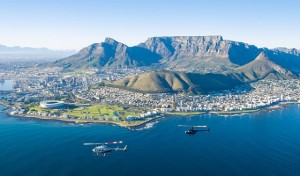 When you say you say Cape Town, you also say table mountain. This imposing mountain is more than a thousand meters high and has a characteristic flattened top. You can walk to the top, but most people go by cable.
When you say you say Cape Town, you also say table mountain. This imposing mountain is more than a thousand meters high and has a characteristic flattened top. You can walk to the top, but most people go by cable.
Table Mountain is the symbol of Cape Town. The flat top is about three kilometres wide with Devil’s Peak and lion’s Head from the East to the West. The highest point on the mountain is 1086 metres high and is marked by Maclear’s Beacon. Often there are clouds around the table mountain, which are called the ‘ tablecloth ‘.
For those with a good condition it is fun to climb the table mountain on foot. When you do, please wear a head covering against the bright sun, long pants and closed shoes. Sometimes the path is very narrow and there are also hoses. Please note that the temperature on the top of table mountain is much lower than in Cape Town itself, it can even be cold! The easiest route is via Platteklip Gorge.
Most people go with the cable car to the top. The ground station is quite far from the center of the city. To get there from the city centre with a minivan (rikki) you will pay you 10 to 15 edge, with a taxi costs the it about 60 edge.
departure from Table Mountain Road
Kirstenbosch National Botanical Garden
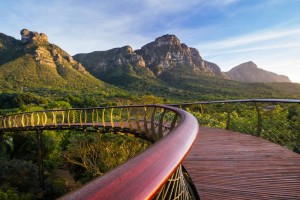 This Botanical Garden is one of the most beautiful in the world, if only because of its location: against the East side of table mountain, with views of Cape Town and the Hottentots Holland Mountains in the distance. The collection consists solely of native plants, flowers and shrubs throughout the year for a true color explosion.
This Botanical Garden is one of the most beautiful in the world, if only because of its location: against the East side of table mountain, with views of Cape Town and the Hottentots Holland Mountains in the distance. The collection consists solely of native plants, flowers and shrubs throughout the year for a true color explosion.
The very large collection Protea (sugarforest) is worth watching. This beautiful flowering plants are common in the South African fynbos. The King Protea – also called Giant protea or honey pot – is the national flower of the country.
Other highlights include the large garden with cycads, the bird bath (a pond that was built around a bright source), and the garden that Smells good is accessible to wheelchairs and explanations in braille available about the collection of flowers. There is also a garden with medicinal plants.
Rhodes Drive (Newlands), Cape Town
Cape of good hope and Cape Point
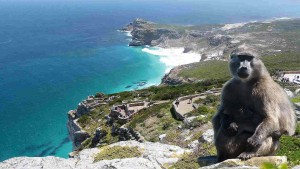 Cape of good hope and Cape Point were originally a separate nature reserve, but now are a part of the Table Mountain National Park. The reserve consists of hilly landscape that is mainly covered with fynbos, a collective name for the fauna on the Cape that mainly consists of bushes and low trees. In total, there are about 1500 species of trees, plants and flowers to be found!
Cape of good hope and Cape Point were originally a separate nature reserve, but now are a part of the Table Mountain National Park. The reserve consists of hilly landscape that is mainly covered with fynbos, a collective name for the fauna on the Cape that mainly consists of bushes and low trees. In total, there are about 1500 species of trees, plants and flowers to be found!
The park is crossed by hiking trails. At the entrance you can get a ticket. Watch out for the brutal baboons at the parking lot. Don’t feed them, because then the will become less shy. Baboons can also be aggressive. There are already many baboons shot because they tried to steal food from homes. With the feeding of the animals you can make this situation worse. There is therefore a fine on feeding baboons.
to the M65 (Plateau Road, Cape Town
Township Tour
 Since the abolition of differency the township tours became very popular. You will see the other side of South Africa: differency may be gone, many colored South Africans still live in poverty in separate areas. These slums are located on the flat country behind table mountain and are therefore also called Cape Flats. They sometimes have names that are in stark contrast with the reality. So does the name of the township Langa mean ‘Sun’ and Gugulethu means ‘our pride’. Join in on a Township tour will give you a realistic picture of life in a Township and gives you the ability to instantly to support local projects.
Since the abolition of differency the township tours became very popular. You will see the other side of South Africa: differency may be gone, many colored South Africans still live in poverty in separate areas. These slums are located on the flat country behind table mountain and are therefore also called Cape Flats. They sometimes have names that are in stark contrast with the reality. So does the name of the township Langa mean ‘Sun’ and Gugulethu means ‘our pride’. Join in on a Township tour will give you a realistic picture of life in a Township and gives you the ability to instantly to support local projects.
Two Oceans Aquarium
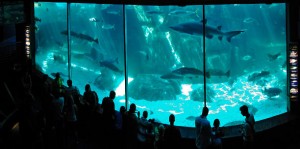 One of the most beautiful museums about the marine life is without a doubt the Two Oceans Aquarium in Cape Town. The name refers to the coming together of two oceans on this place: the cold water of the Atlantic Ocean and the warm water of the Indian Ocean.
One of the most beautiful museums about the marine life is without a doubt the Two Oceans Aquarium in Cape Town. The name refers to the coming together of two oceans on this place: the cold water of the Atlantic Ocean and the warm water of the Indian Ocean.
The aquarium has six sections, starting with the two ‘ Oceans of Contrast ‘. In one basin you see the underwater life of the Atlantic Ocean (cuttlefish, seahorses, jellyfish and the huge spider crab), in the other that of the Indian Ocean (very colorful fish including the sunfish). The biggest attraction is the colony of African penguins that are fed daily at 11:30 and 14.30. In the Kelp Forest Exhibit you’ll see how rich the plant life under water can be. In this basin are swimming a lot of fish and you can swim with them, provided you have a diving license.
Spectacular is the largest basin (2 million litres of water) with sand tiger sharks and other predatory fish. Also you can take a dip, provided you have a diving license. You can do that with your own equipment or in an antique diving suit! The sharks are fed every day at 15.00.
Dock Road, Cape Town
Gold of Africa Museum
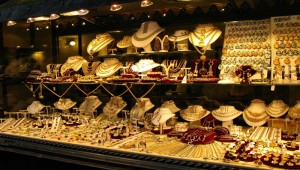 This museum was set up by one of the largest gold producers in the world, Anglo Gold, and is housed in the historic Martin Melck House from 1783. It is dedicated solely to the gold of Africa, not just South Africa but also gold from countries like Ghana (Gold Coast), Mali, Senegal and Ivory Coast.
This museum was set up by one of the largest gold producers in the world, Anglo Gold, and is housed in the historic Martin Melck House from 1783. It is dedicated solely to the gold of Africa, not just South Africa but also gold from countries like Ghana (Gold Coast), Mali, Senegal and Ivory Coast.
You will see spectacular jewelry, crowns and other objects of gold. you will marvel at the craftsmanship of the African goldsmiths in the 19th and 20th centuries. The collection gets something magical during the Pangolin Night Tour on Wednesday night, if you go with a flashlight looking for the Golden Armadillo (pangolin). This tour will end with a glass of wine with real gold leaf. The museum also organises guided tours of the city along the (sometimes Golden) Lions images of Cape Town.
In addition to the permanent collection there are varying exhibition of gold operation from other parts of the world.
96 Strand Street, Cape Town
South African National Gallery
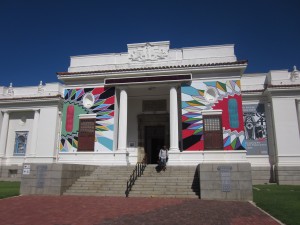 The base of the National Gallery is a (European) collection of paintings from the 17th to the 20th century. The museum bought more and more work of artists from southern Africa in recent years. The very probing ‘ The Butcher Boys ‘ is one of the top pieces.
The base of the National Gallery is a (European) collection of paintings from the 17th to the 20th century. The museum bought more and more work of artists from southern Africa in recent years. The very probing ‘ The Butcher Boys ‘ is one of the top pieces.
The origin of this museum is the private collection of Sir Thomas Butterworth who in 1872 was housed in a museum. After that, the collection expanded. Which now consists of a large collection of European art from the 17th to the early 20th century from Great Britain, The Netherlands, Flanders and France. But the museum focuses more and more on the modern art since 1990 from southern Africa. There is no art of the colonial era. The white rulers had no use for it and after the abolition of differency there were no funds to buy such works of art.
Government Avenue, Cape Town
Robbeneiland
The infamous Robben Island was best known as the long-lasting, forced residence of Nelson Mandela, the freedom fighter who was president of South Africa from 1994 to 1999. Robben Island was also used as a leper colony and military base. The Dutch East Indian Company made it all right after establishment of a penal colony on the Cape. The waters around Robben Island are freezing cold and there are also swimming sharks around the island. The island is now a museum, dedicated to the horrors of the differency regime.
Robbeneiland, Cape Town
Slave Lodge
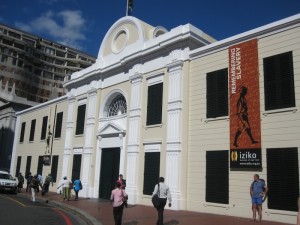 The bitter history of the slave trade comes to life in the Slave Lodge. Previously, the South African cultural history Museum was located here, now it is a museum about the slave trade and the rich diversity of the population of South Africa. The building dates back to 1679, making it one of the oldest buildings in Cape Town. As the name implies there were slaves of the Dutch East India Company (VOC) in accommodated but also criminals and mentally disturbed. From 1815 until 1914, this was the home of the Supreme Court.
The bitter history of the slave trade comes to life in the Slave Lodge. Previously, the South African cultural history Museum was located here, now it is a museum about the slave trade and the rich diversity of the population of South Africa. The building dates back to 1679, making it one of the oldest buildings in Cape Town. As the name implies there were slaves of the Dutch East India Company (VOC) in accommodated but also criminals and mentally disturbed. From 1815 until 1914, this was the home of the Supreme Court.
Of the cultural history Museum are still (varying) collections on display include archaeological finds, Colonial furniture, coins, clothing, silver, glass and weapons. There is ceramics. From South Africa there is a collection of ceramics that at the beginning of the last century was made in the elephant fountain, but there is also a comprehensive collection of the Tang dynasty from China.
49 Wale Street (on the corner of Adderley Street), Cape Town

